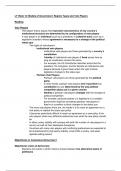Lecture notes
GV101 Lent Term Lecture, Reading and Class Notes
- Institution
- London School Of Economics (LSE)
The course is an introduction to politics in a globalised world, with a focus on how political science tries to understand and explain cross-country and cross-time differences. The course will begin by introducing students to some of the main empirical variations in political behaviour, political i...
[Show more]



